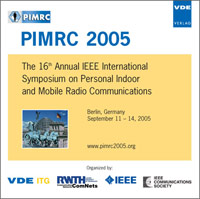Indoor Channel Measurements and Analysis in the Frequency Bands 2 GHz and 60 GHz
Conference: PIMRC 2005 - 16th Annual IEEE International Symposium on Personal Indoor and Mobile Radio Communications
09/11/2005 - 09/14/2005 at Berlin, Germany
Proceedings: PIMRC 2005
Pages: 5Language: englishTyp: PDF
Personal VDE Members are entitled to a 10% discount on this title
Authors:
Yang, Haibing; Smulders, Peter F. M.; Herben, Matti H. A. J. (Radio Communications Group (TTE-ECR), Faculty of Electrical Engineering, Eindhoven University of Technology, The Netherlands)
Abstract:
This paper describes the wideband measurements conducted at the frequencies 58 GHz and 2.25 GHz in an indoor environment. Normalized received power (NRP) and root-mean-squared (RMS) delay spread are calculated and used to compare the characteristics of radio wave propagation in both line-of-sight and non-line-of-sight areas at the two frequencies. The results show that on top of the difference in free space, the NRP at 58 GHz is several dBs lower than at 2.25 GHz in average. This difference is also reflected in the fitted log-(virtual) distance NRP models. In the deep shadow region, the poor diffraction level at 58 GHz will reduce the power level, but meanwhile the reflected waves from walls have a strong contribution to the received signal. In addition, it is observed that the radio channel at 58 GHz shows much less time dispersion in terms of RMS delay spread. The results can be quite useful for the 60 GHz system design, which might be very different from the design of conventional systems which operate in the lower frequency bands.


